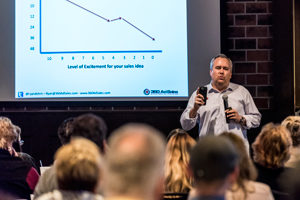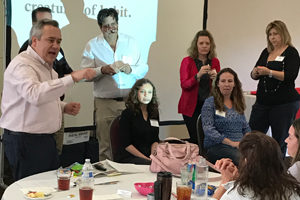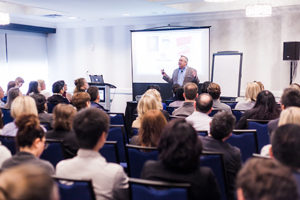Stop Being Ghosted by Your Advertisers
Stop Being Ghosted by Your Advertisers
6 ways to stop advertisers from simply disappearing after a sales call
Ghosting is a relatively new colloquialism that refers to the act of abruptly cutting off contact with someone, without giving that person any warning or explanation for doing so. Even when the person being ghosted reaches out to reinitiate contact or gain closure, they’re met with silence.
Out here in sales land this phenomenon happens to all of us and, unfortunately, often at a higher frequency than we would like to admit.
Has this happened to you? You had a great meeting with a potential advertiser and they’ve asked you for a proposal. You go back to the office and you are excited. You create the proposal. You send over the requested proposal with the anticipation of hearing back soon. Then, everything goes dark. You hear nothing. Every day you play a game of what feels like hide and seek. You reach out by email or phone. You hear nothing. In some cases, you begin to stalk the advertiser by driving past their business. You hear nothing. At a certain point, you become frustrated with yourself. You think maybe you did something wrong. Well, maybe you did.
Ghosting is not necessarily a new phenomenon for salespeople, it’s just that now the behavior has an actual name associated with it. And since it’s really nothing new for a salesperson to experience, why are we surprised when it happens yet again?
But it doesn’t have to be like this, generally speaking. So let’s look at six ways to avoid being ghosted by an advertiser.
STRATEGY #1: Acknowledge the ghost. At the beginning and end of every sales call with a client, I’m vividly clear about the expectations for the meeting and the expectations for the follow-up. Because typically, there are two awkward moments in every sales call. The beginning. And the end. So, why not just talk about it upfront?
For example, I might say, “Thank you so much for the time today, Bob. At the end of our conversation today I would love to set up a clear plan for follow-up. If your answer is yes … wonderful. If your answer is no … that’s okay, we can always work together at some point in the future. Or, if your answer is that you need to think about it … that’s no problem. We’ll set a very clear plan for following up together. A plan that meets your exact needs and decision-making timeline.”
When you begin sales calls by setting yourself up for success, you normally end the sales call with success. If you begin the sales call with a bunch of the normal bologna that accompanies the typical rapport-building, then you are destined to end the call with an equal amount of bologna.
STRATEGY #2: You must own the follow-up process or you will lose the deal. Very often salespeople will give control of the follow-up over to the advertiser. And very often the advertiser will say they will call you back. We all know this is a flat-out lie, in most cases. So, why do we allow the advertiser to control the follow-up? Because we don’t know what else to do. But know this: there should always be a plan in place to control the follow-up with the advertiser.
Very often I will end the sales call by getting out my phone or looking at my calendar and creating a meeting invite for the follow-up. When I create that follow-up I create a short, 10-minute meeting on the calendar. That way when the follow-up meeting appears on the advertiser’s calendar, it looks like a very short meeting and is less likely to be canceled.
STRATEGY #3: Agree on the best plan for follow-up. A lot of times when you end the sales call, there is not a clear plan nor an agreed-upon plan. Take ownership of the follow-up and be sure that both parties agree that the follow-up plan is crystal clear. You might even ask some questions like, “What is the best way for me to follow up with you? Do you prefer texts? Smoke signals? Carrier pigeon? Or email?”
Now, all kidding aside, my follow-up preference would be by phone. But if you happen to be selling in a local sales environment, you could set the follow-up to be a quick drop-in. You might be thinking to yourself … what if the advertiser wants to call me back and they refuse to set the follow-up? At that point, I believe you need to acknowledge the circumstance as it has been laid in front of you. I would ask this question: “If this is a marketing idea that you love I would think a follow-up would make a ton of sense, right? If this is not an idea that you love and you’re just being kind to me, please let me know. My goal here is to help and not to be a waste of your time.”
STRATEGY #4: Texting may be the best way to follow up. Ugh. Yes, I said it. I consider myself to be a technology expert. I absolutely love technology. I believe that technology has really helped salespeople increase our sales games and be more productive. But I admit that I am not a huge fan of texting advertisers.
The reason is because of the personal nature of texting. However, with that said, I have definitely seen a large majority of my clients move to texting as a quick way to follow up. To that end, at the close of a sales call, I want to make sure that I get the advertiser’s permission to text them. Sure, you probably don’t need to do this, but I just like to have someone’s permission before I’m texting to their personal cell phone. Call me old-school if you want. I will wear it with a badge of honor. But please understand, I do recognize that texting is an important part of the sales process.
STRATEGY #5: Be safe, but recognize that face-to-face is still the best way to sell. My comments are not meant to be political in any way. I want everybody to be safe, and as a survivor of COVID-19, I would never wish it upon my worst enemy. I’m finding that most advertisers I’m working with are fine with face-to-face meetings. But be safe out there. Because it is hard to ignore that face-to-face meetings are better than virtual meetings. And yet we know that virtual meetings are always better than phone meetings.
So whatever you need to do out there, be safe, but recognize that getting in front of advertisers is a very important part of being a professional in the sales business. It is harder for an advertiser to ghost you after they have a personal, face-to-face conversation and connect with you.
STRATEGY #6: Present ideas on the spot. I have preached about this for years. You are not selling a cure for cancer. You are selling and recommending marketing options. So why are you not going to the sales call armed with a proposal filled with great ideas? Because someone has convinced you that you cannot create a proposal until you know the advertiser’s “needs.” This is just not true. Any given advertiser in any given category is going to normally do three to six things to be successful. Period. So look at the past success other advertisers have had in a certain category and make educated recommendations. While on the sales call, tweak what you brought to better fit the advertiser’s needs. There is truly no reason to leave to create a proposal. This is an invitation to be ghosted. Why give that invitation?
If you’re a reader of my column on a regular basis, you’ll know that I’m all about having an organized sales plan of attack. I do like to be a little unorthodox at times, though, because breaking up consistent patterns of failure is very important to success. But still, never forget that failing to plan is planning to fail. And I believe that in the sales business, this quote is more accurate than ever.
In closing, ghosting is just something that’s going to occur in the sales business. It’s a part of the sales process. Be prepared for it. Any plan is better than no plan at all.
And never forget, if ad sales was easy everybody would be doing it. And they are not. We are the chosen few. We have found amazing media careers that will feed our families for a lifetime.



